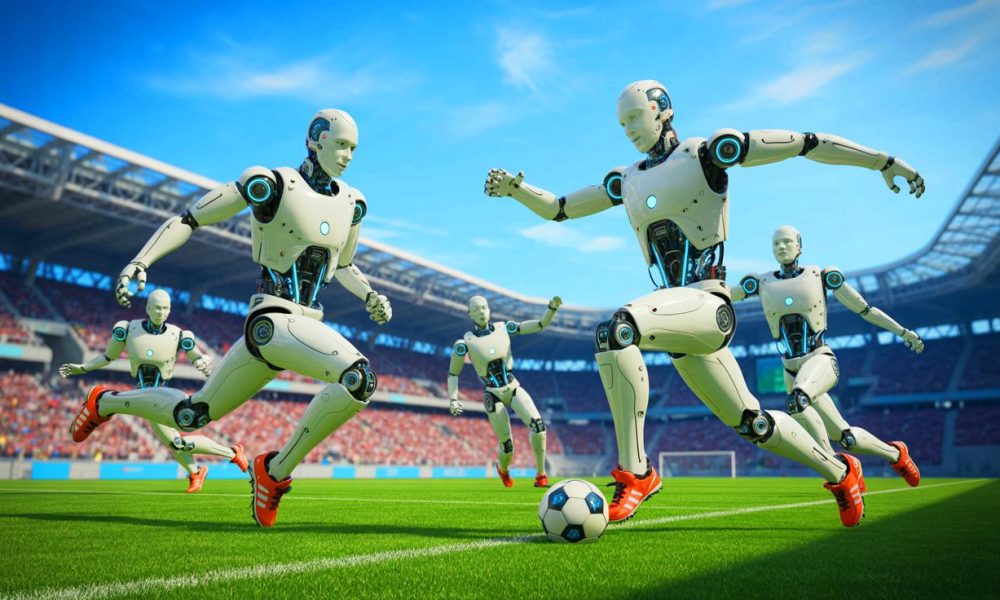Technology
“Robot Teams Storm the Field”: China Hosts First-Ever Soccer Tournament With Fully Autonomous Humanoid Players in Action
IN A NUTSHELL ⚽ The Robo League tournament in Beijing featured fully autonomous humanoid robots competing in a groundbreaking soccer event. 🤖 Each team consisted of three robots equipped with advanced sensors and AI, showcasing impressive agility and decision-making skills. 🎯 The tournament marked a significant milestone in merging technological innovation with sports and real-world […]

| IN A NUTSHELL |
|
In a groundbreaking fusion of technology and sports, Beijing recently witnessed the thrilling climax of the Robo League robot football tournament. This event marked a significant milestone in autonomous technology as humanoid robots competed without human intervention. The tournament was not just a spectacle of cutting-edge innovation but also a precursor to the much-anticipated 2025 World Humanoid Robot Sports Games. As the robots took to the field, they showcased remarkable agility and intelligence, drawing attention from tech enthusiasts and sports fans alike. This tournament highlighted the potential of robotics in redefining the future of sports and everyday life.
The Thrill of Autonomous Soccer
The Robo League tournament in Beijing represented the first fully autonomous robot soccer event ever held in China, capturing the imagination of audiences worldwide. Each team consisted of three humanoid robots, with one substitute, competing in two 10-minute halves separated by a brief intermission. During the match, the robots demonstrated impressive skills, including walking, running, and kicking, all while making real-time decisions without human guidance.
Equipped with advanced optical cameras and sensors, these robots could detect the ball from up to 65 feet away with over 90 percent accuracy, identifying crucial elements such as field lines, goals, teammates, and opponents. The tournament’s executive director, Dou Jing, emphasized that this event was a significant step in merging technological innovation with industrial application. Despite minor limitations, such as challenges in dynamic obstacle avoidance, the tournament was hailed as a success, paving the way for future advancements in autonomous sports.
“China Cuts the Cord”: Home-Grown Operating System Tested in Space to Eliminate Reliance on Foreign Tech
Expanding the Horizon of Robot Sports
Looking ahead, organizers plan to broaden the scope of sports played by humanoid robots. The goal is to introduce more intellectual properties and enhance the level of competition. Currently, the soccer level is comparable to that of young children, but expectations are high for future improvements as technology advances. In a notable past event, the Tiangong Ultra robot participated in a long-distance race, completing a 13-mile course, showcasing the potential for diverse athletic applications.
The upcoming 2025 World Humanoid Robot Sports Games, scheduled for August 15-17 in Beijing, promises to be a spectacular showcase of robotic prowess. The event will feature 11 sport categories modeled on traditional human competitions, including track and field, gymnastics, and synchronized dancing. This evolution in robot sports not only highlights technological progress but also offers a glimpse into the future of entertainment and public engagement with robotics.
“90% Less Power, Same Punch”: New Quantum Amplifier Redefines Energy Efficiency Without Compromising Signal Strength
Technological Innovation Meets Real-World Application
The Robo League tournament demonstrated the potential for robots to transition from controlled environments to real-world scenarios. By allowing the robots to operate autonomously, the event underscored the strides made in artificial intelligence and robotics. The tournament’s success is a testament to the relentless pursuit of innovation in these fields, with applications extending beyond sports into various aspects of daily life.
This competition was more than just a game; it was a platform for showcasing how robots can integrate into society, handling tasks that require agility, precision, and decision-making. As robots become more sophisticated, they hold the promise of revolutionizing industries, from manufacturing to healthcare, and even domestic environments. The Robo League has set the stage for future advancements and collaborations between technology and society.
This Alien-Like Lichen Could Build Martian Cities—Synthetic Organism 3D Prints Homes Straight from Red Planet Soil
The Road to the 2025 World Humanoid Robot Sports Games
As Beijing prepares to host the 2025 World Humanoid Robot Sports Games, the focus is on showcasing the world’s most advanced humanoid robots. The event will not only highlight sporting competitions but also challenge robots in real-world scenarios, pushing the boundaries of what autonomous machines can achieve. This international gathering will serve as a platform for innovation, collaboration, and inspiration for the next generation of roboticists and engineers.
With a lineup of 11 sport events, the Games are set to captivate audiences and provide a unique opportunity to witness the convergence of sports and technology. This event will build on the foundation laid by the Robo League, furthering the dialogue on how robots can enhance human life and capabilities. As we look to the future, the question remains: How will these advancements shape the relationship between humans and machines in the decades to come?
In conclusion, the Robo League tournament and the upcoming World Humanoid Robot Sports Games represent a remarkable intersection of sports and technology. These events offer a glimpse into a future where robots play a greater role in entertainment and everyday life. As we continue to explore the possibilities, one must ask: How will these innovations redefine our understanding of competition and collaboration in the modern world?
Our author used artificial intelligence to enhance this article.
Did you like it? 4.5/5 (21)